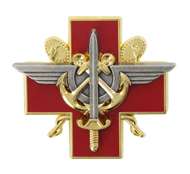French Defence Health Service
| Service de santé des armées | |
|---|---|
 Logo of the French Defence Health service | |
| Country | France |
| Allegiance | Armée française |
| Commanders | |
| Current commander | Médecin général des armées Jean-Marc Debonne[1] |
French Defence Health Service (Service de santé des armées or SSA) is responsible for medical and sanitary support of the French military and of all institutions placed under the authority of the French Ministry of Defence. It is a joint service, and its central administration (direction centrale du service de santé des armées, DCSSA)is under the direct control of the Chief of the defence staff (chef d'état-major des armées (CEMA)).
Its significant presence on French territory ensures adequate support for French operations in overseas theatres. It provides hospital care services, administers medicals for military personnel, and gives expertise in disease prevention, and medical, dental, pharmaceutical, paramedical and veterinary research and education.
Physicians and chemists receive initial training in Bordeaux and Lyon. Then, they are sent to the Val de Grâce Hospital in Paris for applied training. Dentists and vets are recruited in the civilian labour market. The service also includes administrative and technical officers (OCTASSA), nurses (males and females) and paramedical staff.
History
The health services of the French army and navy were set up by Louis XIV with the 17 January 1708 edict which established royal doctors and surgeons offices.
During The French Revolution (1789–1799) and the Napoleonic Empire (1804–1814), changes were required due to successive mobilisations. So, military hospitals were set up in religious buildings such as the Val-de-Grâce church in Paris.
In 1882, the French Parliament gave the military health services a degree of independence. Subsequently, eight hospitals, two schools (in Lyon and Bordeaux), as well as research and sanitary supply agencies were gradually acquired.
In 1890, the Military Medical Schools at Bordeaux and Lyon opened. Bordeaux educated for the Navy and colonial troops, while Lyon educated for l'Armee de terre and the new Air Force.
In 1962, a central management of the military health services was established. In 1968, all of the military health services (Navy, Air Force, Army, Gendarmerie, etc.) merged to form a single joint Defence Health Service.
On July 2, 2011, the School of Army Health (ESA) was established as part of a rationalisation of the armed forces, meaning the closure of Bordeaux, making Lyon the only school of military institution providing the first six years of medical and pharmacist training in the armed forces. The ESA inherits the traditions of both schools.
Notable characters in the history of the French military health services include:
- Baron Pierre-François Percy (1754-1825), surgeon-in-chief during the Revolution and the Empire;
- Dominique Jean Larrey (1766-1842), father of emergency medicine;
- Louis Jacques Bégin (1793-1859), surgeon of the First Empire and to the second president of the Academy of Medicine in 1847;
- Robert Picqué (1877-1927), pioneer of medical transport by air;
- Charles Louis Alphonse Laveran (1845-1922), won the Nobel Prize for medicine in 1907 for discovering that malaria is caused by a protozoan;
- Henri Laborit (1914-1995), surgeon, discoverer of neuroleptics, neurobiologist ... ;
- Valérie André, a pioneer in medical evacuation by helicopter during the Indochina War.
Missions
Health support to the armed forces
The primary mission of the SSA is to provide medical support to armed forces personnel. It is responsible for ensuring their suitability for operations, at their application, throughout their careers, and beyond, assessing their physical and mental health. (selection, fitness, immunizations, care, protection, health education etc.).
On operations, the SSA support the sick and wounded from outset until full recovery. It is organised into four levels:
- Emergency actions and resuscitation performed by the medical post in combat units,
- Surgical treatment necessary for survival and prevention of complications in field hospitals,
- Treatment of the wounded on the scene in a medical-surgical hospital
- Evacuation for further treatment to the Army Teaching Hospital in France
Medical support to out-of-area operations
The French defence health service is committed to offering optimal health care quality standards in order to preserve the chances of survival and the physical of the patients.
Therefore, it sets up medical and surgical equipment as close to the casualties as possible. Furthermore, it proceeds to early repatriation of injured soldiers to military hospitals in France.
Humanitarian involvement
The humanitarian side of the French Defence Health Service focuses on post-disaster emergency relief and medical support to populations stricken by conflicts.
Moreover, during out-of-area operations, though prioritizing medical support to its own forces, it provides medical assistance to local populations.
Unique ranks of the SSA
Doctors hold the following ranks:
- Interne ("Intern", equivalent to a lieutenant). A rank invented in 2005.
- Médecin ("Doctor", equivalent to a capitaine)
- Médecin principal ("Lead Doctor", equivalent to a commandant)
- Médecin en chef ("Doctor-in-Chief", equivalent to a lieutenant-colonel or colonel according to seniority)
- Médecin chef des services classe normale ("Chief Doctor of Services, Standard Class", equivalent to a général de brigade)
- Médecin chef des services hors classe ("Chief Doctor of Services, Beyond Class", equivalent to a général de division)
Doctor-Inspectors are Médecins chef tasked with inspecting military medical facilities. They are in two grades:
- Médecin général ("Doctor-General", equivalent to a général de brigade)
- Médecin général inspecteur (equivalent to a général de division)
References
- ↑ "portant affectation et élévation aux rang et appellation de médecin général des armées d'un officier général". Legifrance (in French). Retrieved 13 May 2016.